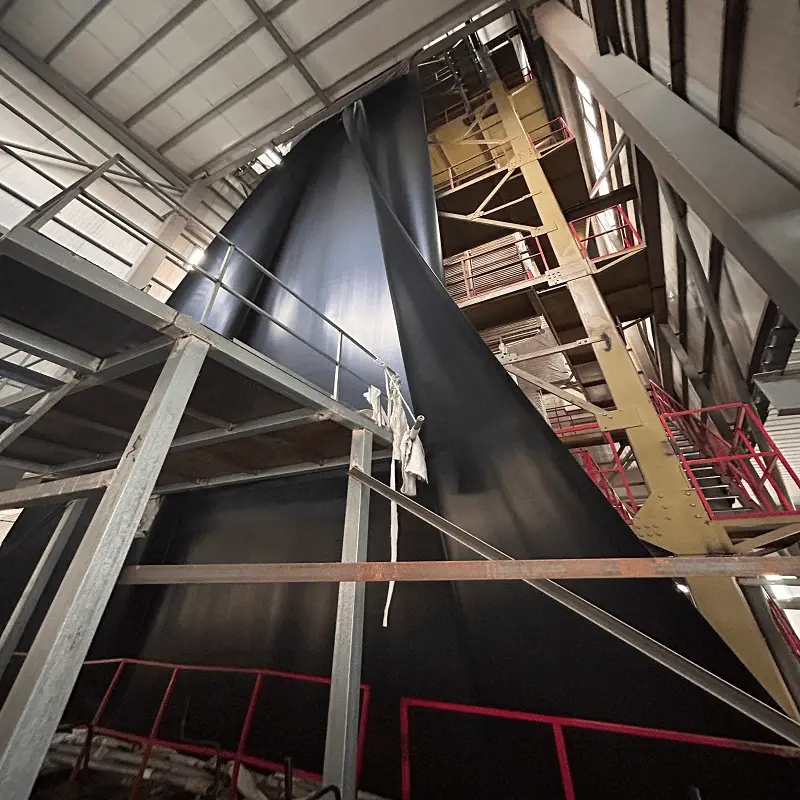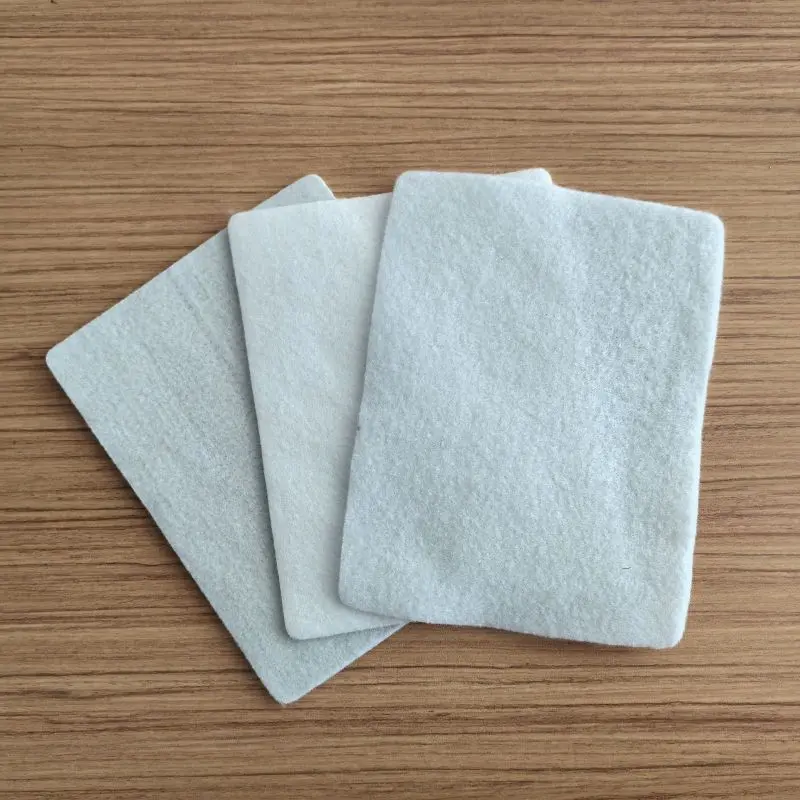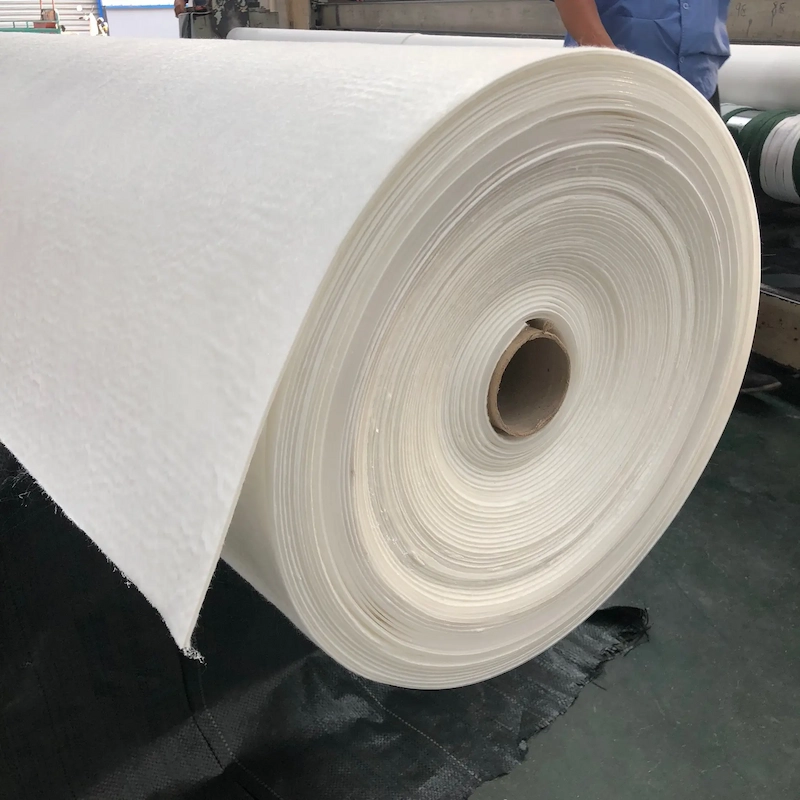Edited by Lucia-Haoyang Environmental
I. Overview of Nonwoven Geotextiles
Nonwoven geotextiles are permeable fabrics made by bonding fibers through mechanical, thermal, or chemical means. Unlike woven geotextiles, they do not have a distinct pattern, resulting in a more uniform and random fiber distribution. This structure imparts high permeability and excellent filtration capabilities.
Key Properties:
· Permeability: Allows fluids to pass through while retaining soil particles.
· Tensile Strength: Provides resistance to stretching and deformation.
· Chemical Resistance: Withstands exposure to various chemicals found in landfill leachate.
· Durability: Maintains functionality over extended periods under harsh conditions.
II. Applications in Landfills
In landfill construction and maintenance, nonwoven geotextiles serve multiple critical functions:
l Filtration: Prevent fine soil particles from clogging drainage systems, ensuring efficient leachate collection.
l Separation: Maintain the integrity of different soil layers, preventing intermixing and preserving structural stability.
l Drainage: Facilitate the movement of fluids, reducing hydrostatic pressure and preventing water accumulation.
l Protection: Shield geomembranes and other impermeable liners from punctures and mechanical damage.
Case Study: Leachate Management
Effective leachate management is crucial in landfill operations. Nonwoven geotextiles play a vital role in the leachate collection system by acting as filters and drainage facilitators. Their high permeability ensures that leachate is efficiently collected and directed to treatment facilities, preventing environmental contamination.
Leachate Collection System Components:
l Liners: Geomembranes that prevent leachate from seeping into the ground.
l Drainage Layer: Nonwoven geotextiles that allow leachate to flow towards collection pipes.
l Collection Pipes: Transport leachate to sumps or treatment areas.
The integration of nonwoven geotextiles in the drainage layer enhances the system's efficiency by preventing soil particles from clogging the pipes, thereby maintaining consistent leachate flow.
689432.webp)
III. Technical Specifications
The performance of nonwoven geotextiles in landfill applications depends on their physical and mechanical properties. This table summarizes typical specifications:
Property | Typical Value Range | Unit |
Mass per unit area | 200 – 800 | g/m² |
Thickness | 1.5 – 5.0 | mm |
Tensile Strength | 10 – 50 | kN/m |
Elongation at Break | 50 – 100 | % |
Permeability | 10-3 – 10-4 | cm/s |
Puncture Resistance | 500 – 2000 | N |
Standard: CJ/T 430-2013
CJ/T 430-2013 is a Chinese industry standard that specifies the terminology, definitions, classifications, requirements, test methods, inspection rules, marking, packaging, transportation, and storage of nonwoven geotextiles used in landfills. The standard applies to nonwoven geotextiles utilized in landfill systems for anti-seepage, drainage, and cover applications.
1. Unit Mass and Thickness
The unit mass (mass per unit area) and thickness are fundamental properties that influence the geotextile's performance. Table 1 summarizes the specifications:
Specification (g/m²) | Thickness (mm) | Thickness Tolerance (mm) |
200 | 2.0 | ±0.2 |
300 | 2.4 | ±0.2 |
400 | 3.1 | ±0.3 |
500 | 3.8 | ±0.3 |
600 | 4.1 | ±0.4 |
800 | 5.0 | ±0.5 |
Table 1: Unit Mass and Thickness Specifications
2. Mechanical Properties
Mechanical properties such as tensile strength, elongation at break, puncture resistance, and tear strength are crucial for ensuring durability and functionality. Table 2 presents the requirements for nonwoven geotextiles used in landfill anti-seepage and drainage systems:
Specification (g/m²) | Tensile Strength (kN/m) | Elongation at Break (%) | Puncture Resistance (kN) | Tear Strength (kN) |
200 | ≥11.0 | 40–80 | ≥2.1 | ≥0.28 |
300 | ≥16.5 | 40–80 | ≥3.2 | ≥0.42 |
400 | ≥22.0 | 40–80 | ≥4.3 | ≥0.56 |
500 | ≥27.5 | 40–80 | ≥5.8 | ≥0.70 |
600 | ≥33.0 | 40–80 | ≥7.0 | ≥0.82 |
800 | ≥44.0 | 40–80 | ≥8.7 | ≥1.10 |
1000 | ≥55.0 | 40–80 | ≥9.4 | ≥1.25 |
Table 2: Mechanical Properties for Anti-Seepage and Drainage Applications
For landfill cover applications, the mechanical property requirements are slightly lower, reflecting the different functional demands. Table 3 outlines these specifications:
Specification (g/m²) | Tensile Strength (kN/m) | Elongation at Break (%) | Puncture Resistance (kN) | Tear Strength (kN) |
200 | ≥6.5 | 40–80 | ≥0.9 | ≥0.16 |
300 | ≥9.5 | 40–80 | ≥1.5 | ≥0.24 |
400 | ≥12.5 | 40–80 | ≥2.1 | ≥0.33 |
500 | ≥16.0 | 40–80 | ≥2.7 | ≥0.42 |
600 | ≥19.0 | 40–80 | ≥3.2 | ≥0.46 |
800 | ≥25.0 | 40–80 | ≥4.0 | ≥0.60 |
Table 3: Mechanical Properties for Cover Applications
3. Hydraulic Properties
Hydraulic properties, including equivalent opening size and vertical permeability coefficient, are essential for filtration and drainage functions. The standard specifies:
l Equivalent Opening Size (O90): 0.05–0.20 mm
l Vertical Permeability Coefficient (k): K × (10-¹–10-³) cm/s, where K = 1.0–9.9
These parameters ensure that the geotextile effectively filters soil particles while allowing fluid flow.
4. Durability
Durability is assessed through artificial weathering tests. The standard requires that after 500 hours of exposure, the geotextile should retain at least 70% of its original tensile strength and elongation at break.
330536.webp)
IV. Environmental Impact and Sustainability
The use of nonwoven geotextiles in landfills contributes to environmental protection by:
l Preventing Contamination: Acting as a barrier to pollutants, they protect groundwater and surrounding ecosystems.
l Enhancing Stability: By reinforcing soil structures, they reduce the risk of landfill failures.
l Promoting Sustainability: Many nonwoven geotextiles are made from recycled materials, aligning with sustainable waste management practices.
Key Data Supporting Environmental Impact
Impact Area | Geotextile Contribution | Benefit |
Leachate Contamination | Reduces seepage by 95–99% | Prevents groundwater contamination and soil degradation. |
Lifespan Improvement | Extends landfill use by 20–30% | Reduces the need for new landfill sites, preserving natural ecosystems. |
Carbon Savings | Up to 40% reduction in transport emissions | Lightweight material reduces energy used during installation and handling. |
V. Installation and Maintenance Considerations
Proper installation is essential to maximize the benefits of nonwoven geotextiles. Key considerations include:
1. Site Preparation
l Clear the Area: Remove sharp objects, debris, or irregularities from the surface to avoid puncturing or damaging the geotextile.
l Level the Ground: Ensure the subgrade is smooth, stable, and compacted to prevent uneven stress on the geotextile.
2. Material Handling
l Storage: Store geotextiles in a clean, dry location to protect them from UV exposure, moisture, and contamination.
l Unrolling: Unroll the geotextile carefully to avoid stretching or tearing. Use appropriate equipment to handle large rolls.
3. Alignment and Overlapping
l Proper Alignment: Align geotextiles correctly to cover the designated area without gaps.
l Overlap Requirements: Overlap adjacent sheets by at least 30–50 cm (depending on project specifications) to prevent soil intrusion or seepage at joints.
l Securing Edges: Use pins, staples, or weights to secure the geotextile during installation to avoid displacement by wind or site activities.
4. Avoiding Damage
l Foot Traffic: Minimize walking or equipment movement directly on the geotextile to prevent punctures.
l Sharp Objects: Avoid tools or machinery with sharp edges that could damage the material.
l Load Placement: Do not drop heavy materials or rocks directly onto the geotextile.
5. Weather Conditions
l Avoid Windy Conditions: Install geotextiles in calm weather to maintain alignment and prevent wrinkling.
l Rain Protection: Avoid installation during heavy rainfall, as water can compromise the subgrade or lead to improper placement.
6. Compatibility with Other Layers
l Geotextile and Liner Interface: Ensure proper contact with geomembranes or liners to enhance anti-seepage properties.
l Drainage Layers: Place drainage aggregates carefully over the geotextile to avoid damage while maintaining its permeability.
7. Quality Inspection
l Visual Inspection: Check for tears, punctures, or inconsistencies in the geotextile during and after installation.
l Seam Testing: Ensure seams and overlaps are properly secured and free from gaps or misalignment.
l Certification: Verify that the installed geotextile meets project specifications and standards (e.g., CJ/T 430-2013).
8. Maintenance Post-Installation
l Regular Monitoring: Inspect the geotextile periodically for signs of wear, damage, or displacement.
l Repair Damage: Patch or replace damaged sections promptly to maintain integrity.
l Protective Covering: Add a protective soil or aggregate layer over the geotextile as soon as possible to shield it from UV exposure and mechanical damage.
VI. Conclusion
Nonwoven geotextiles are integral to modern landfill engineering, offering solutions that enhance structural integrity, environmental protection, and operational efficiency. Their versatility and effectiveness make them a preferred choice in landfill applications worldwide.
![]() 200g geotextiles test report.pdf
200g geotextiles test report.pdf
If you are interested in any of our products, pls feel free to contact me:
Tel: +86 16615773081
Email: lucia@hygeosynthetics.com
191.webp)
373.webp)
832.webp)




